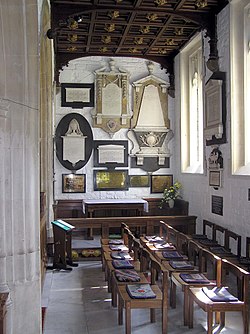Bathampton
| Bathampton | |
| Somerset | |
|---|---|
 Church of St Nicholas, Bathampton | |
| Location | |
| Grid reference: | ST777662 |
| Location: | 51°23’39"N, 2°19’11"W |
| Data | |
| Population: | 1,504 (2001) |
| Post town: | Bath |
| Postcode: | BA2 |
| Dialling code: | 01225 |
| Local Government | |
| Council: | Bath & NE Somerset |
| Parliamentary constituency: |
North East Somerset |
Bathampton is a village in Somerset two miles east of Bath, on the south bank of the River Avon. The parish has a population of 1,504.
The Kennet and Avon Canal passes through the village and a toll bridge links Bathampton to Batheaston on the north bank of the canal.
The parish is part of the Hampton Hundred.
History
Bathampton Camp is a univallate Iron Age hill fort situated approximately two miles east from the village.[1] The site was excavated in 1904–05 and in 1952–54. Results found human and animal remains, pottery and flint flakes.[2]
The village used to have a railway station, but it was closed following the Beeching Report.
Plasticine was manufactured in the village between 1900 and 1983 by a company founded by William Harbutt, who also lived in Bathampton.
Geography

Bathampton Rocks
Above Bathampton is a steep slope, heavily quarried for stone near the top in the area now called Bathampton Rocks, leading to Bathampton Down. Until the late 1950s the track used for bringing stone down into the valley could be seen; it crossed the main A36 road over a short rock bridge known as the Dry Arch. This was demolished in 1958 as it was too low for double-decker buses and other traffic. Bathampton Rocks was the site of the Bathampton Patrol (Auxiliary Units) Operational Base during the Second World War.[3] at ST778651)
Bathampton Meadow

When the A46 Bathampton by-pass was built, an area of 22 acres was created to provide additional flood relief. The wet meadows and the oxbow lake which were made have proved attractive to a number of migrant birds with waders such as dunlin, ringed and little ringed plover, and green and common sandpiper in spring and autumn. Sand martin and kingfisher have been seen regularly by the oxbow, and other migrants have included yellow wagtail, whinchat and hobby.[4] In 2009, the local Council identified the meadows as a possible new park and ride site to alleviate traffic congestion in the city.[5]
Landmarks
Above the village is Sham Castle, a folly built in 1762 by Richard James, master mason for Ralph Allen, "to improve the prospect" from Allen's town house in Bath. It is a screen wall with a central pointed arch flanked by two 3-storey circular turrets, which extend sideways to a 2-storey square tower at each end of the wall.[6] It is illuminated at night.[7]
Church


In the 13th century John Stafford, who later became the Archbishop of Canterbury, was the vicar of Bathampton.[8]
The Parish Church of St Nicholas has 13th-century origins with 15th-century alterations and tower. In the mid 18th century Ralph Allen added Gothic]] components after he acquired Bathampton Manor by marriage in 1731. The building was further restored]] and the north aisle built in 1858 by Henry Goodridge and the chancel was restored in 1882 by C.E. Davis.[9] The "Australia Chapel" in the south aisle contains memorials to the Allen family and to Admiral Arthur Phillip, the first Governor of New South Wales.[7] Phillip was buried in the church after his death in 1814 and although it was unnoticed for many years, the grave was discovered in 1897[10] and the Premier of New South Wales, Sir Henry Parkes, had it restored. The windows of the sanctuary carry the coat of arms of the Federal Government and the six Australian States.
Buried in the church yard is the body of the French aristocrat, Adolphe, Vicomte du Barry, a nephew-by-marriage and close personal friend of Madame du Barry, Louis XV's legendarily beautiful mistress. The Vicomte had been living in nearby Bath when he was killed in a duel with an Irish adventurer, Captain Rice.[11]
Outside links
| ("Wikimedia Commons" has material about Bathampton) |
References
- ↑ "Archaeological Aerial Survey in the Northern Mendip Hills: A Highlight Report for the National Mapping Programme". English Heritage. p. 32. http://www.english-heritage.org.uk/publications/archaeological-aerial-survey-northern-mendip-hills-nmp/Northern_Mendip_Hills_AONB_NMP_Report_web.pdf. Retrieved 29 January 2011.
- ↑ "Pastcape Bathampton investigation". Pastcape. http://www.pastscape.org.uk/hob.aspx?hob_id=203244&sort=4&search=all&criteria=Bathampton%20Camp&rational=q&recordsperpage=10. Retrieved 10 May 2011.
- ↑ "Bathampton Patrol". http://www.subbrit.org.uk/sb-sites/sites/b/bathampton_patrol_au_ob/index.shtml. Retrieved 21 November 2007.
- ↑ "Bathampton Meadow". Reserves. Avon Wildlife Trust. http://www.avonwildlifetrust.org.uk/reserves/bathampton.htm. Retrieved 1 October 2010.
- ↑ Morris, Steven (25 May 2009). "Plan to turn Bath's historic meadows into car park provokes fury". The Guardian (Guardian Media Group). http://www.guardian.co.uk/environment/2009/may/25/bath-meadows-car-park. Retrieved 15 July 2011. "Bath and North East Somerset council wants to build a park and ride for 1,400 cars on land to the east of the city [...]"
- ↑ "Sham Castle". Images of England. http://www.imagesofengland.org.uk/Details/Default.aspx?id=32038. Retrieved 15 March 2008.
- ↑ 7.0 7.1 Scott, Shane (1995). The hidden places of Somerset. Aldermaston: Travel Publishing Ltd. pp. 16–17. ISBN 1-902007-01-8.
- ↑ Dunning, Robert (2005). A Somerset Miscellany. Tiverton: Somerset Books. pp. 32–33. ISBN 0-86183-427-5.
- ↑ National Heritage List 1016574: Parish Church of St Nicholas
- ↑ St Nicholas Church, Bathampton, Burial place of Arthur Phillip
- ↑ Joan Haslip, Madame du Barry: The Wages of Beauty, (1992), p. 120